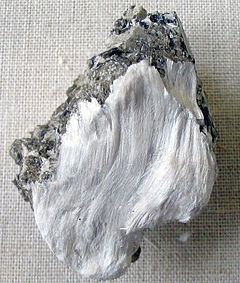
What is Asbestos -
Asbestos (pronounced /æsˈbɛstəs/ or /æzˈbɛstəs/) is a set of six naturally occurring silicate minerals used commercially for their desirable physical properties.[1] They all have in common their eponymous asbestiform habit: long (roughly 1:20 aspect ratio), thin fibrous crystals. The prolonged inhalation of asbestos fibers can cause serious illnesses including malignant lung cancer, mesothelioma, and asbestosis (a type of pneumoconiosis).[2][3] The trade and use of asbestos have been restricted or banned in many jurisdictions.
Asbestos became increasingly popular among manufacturers and builders in the late 19th century
because of its sound absorption, average tensile strength, its resistance to fire, heat, electrical
and chemical damage, and affordability. It was used in such applications as electrical insulation
for hotplate wiring and in building insulation. When asbestos is used for its resistance to fire
or heat, the fibers are often mixed with cement (resulting in asbestos cement) or woven into fabric
or mats.
[top]
Types of Asbestos
Chrysotile
Chrysotile, CAS No. 12001-29-5, is obtained from serpentinite rocks which are common throughout
the world. Its idealized chemical formula is Mg3(Si2O5)(OH)4.[7] Chrysotile appears under the
microscope as a white fiber.
Chrysotile has been used more than any other type and accounts for about 95% of the asbestos found
in buildings in America. Chrysotile is more flexible than amphibole types of asbestos, and can be
spun and woven into fabric. Its most common use has been in corrugated asbestos cement roof sheets
typically used for outbuildings, warehouses and garages. It may also be found in sheets or panels
used for ceilings and sometimes for walls and floors. Chrysotile has been a component in joint
compound and some plasters. Numerous other items have been made containing chrysotile, including
brake linings, fire barriers in fuseboxes, pipe insulation, floor tiles, and gaskets for high
temperature equipment.[citation needed]
Amphibole
Amphibole class fibers are needle-like. Amosite, crocidolite, tremolite, anthophyllite and actinolite
are members of the amphibole class.
Amosite
Amosite, CAS No. 12172-73-5, often referred to as brown asbestos, is a trade name for the amphiboles
belonging to the cummingtonite-grunerite solid solution series, commonly from South Africa, named as
an acronym for "Asbestos Mines of South Africa". One formula given for amosite is
Fe7Si8O22(OH)2. Amosite is seen under a microscope as a grey-white vitreous fiber. It is found
most frequently as a fire retardant in thermal insulation products, asbestos insulating board and
ceiling tiles.[8]
Crocidolite
Crocidolite, CAS No. 12001-28-4, is the fibrous form of the amphibole riebeckite, found primarily
in southern Africa, but also in Australia and Bolivia. One formula given for crocidolite is
Na2Fe2+3Fe3+2Si8O22(OH)2. Crocidolite is seen under a microscope as a blue fiber.
Crocidolite commonly occurs as soft friable fibers. Asbestiform amphibole may also occur as soft
friable fibers but some varieties such as amosite are commonly straighter. All forms of asbestos
are fibrillar in that they are composed of fibers with breadths less than 1 micrometer that occur
in bundles and have very great widths. Asbestos with particularly fine fibers is also referred to
as "amianthus".
Other materials
Other regulated asbestos minerals, such as tremolite asbestos, CAS No. 77536-68-6, Ca2Mg5Si8O22(OH)2;
actinolite asbestos, CAS No. 77536-66-4, Ca2(Mg, Fe)5(Si8O22)(OH)2; and anthophyllite asbestos,
CAS No. 77536-67-5, (Mg, Fe)7Si8O22(OH)2; are less commonly used industrially but can still be
found in a variety of construction materials and insulation materials and have been reported in
the past to occur in a few consumer products.
Size of asbestos fibers compared to other particles (USEPA, March, 1978
Other natural and not currently regulated asbestiform minerals, such as richterite, Na(CaNa)(Mg,
Fe++)5(Si8O22)(OH)2, and winchite, (CaNa)Mg4(Al, Fe3+)(Si8O22)(OH)2, are thought by some to be no
less harmful than tremolite, amosite, or crocidolite.[9] They are referred to as "asbestiform
" rather than asbestos. Although the U.S. OSHA has not included them in the asbestos standard,
NIOSH and the American Thoracic Society have recommended that they be included as regulated
materials. As such, they may still be related to diseases and hazardous.[9]
[top]
Asbestos Abatement -
Asbestos is a naturally occurring fibrous mineral that is used in many applications for its fire
resistance, noise insulation and electrical insulation properties. Com- mon uses prior to the
mid-1970's included building products such as pipe insulation, acoustical soundproofing, house
insulation, fireproofing, house siding, floor coverings, roofing materials and heating and
cooling systems.
There are two general forms of asbestos: friable and non-friable. Friable asbestos can be crumbled,
pulve- rized or reduced to a powder by hand pressure when dry and is the most dangerous form.
Non-friable as- bestos cannot easily be pulverized or reduced to a powder. Nonfriable asbestos
that is damaged to the extent that it can be crumbled or reduced to a powder by hand pressure
must be handled and packaged like friable asbestos wastes. Resilient floor tile, roof felts,
asphalt tiles, asphalts, mastics, and transite roofing shingles, siding and piping are considered
non-friable forms of asbestos, unless they are or will be damaged during demolition or
renovation activities.
Inhalation of asbestos fibers may cause cancer, so in- halation of asbestos fibers and dust must be
avoided. The most important thing in handling, trans- porting or disposing of asbestos is to do so
in a way that prevents airborne release of fibers or dust.
1. Alleman, James E., & Mossman, Brooke T; Mossman (July 1997). "Asbestos Revisited". Scientific American 277: 54–57. Bibcode:1997 SciAm.277a..70A. doi:10.1038/scientificamerican0797-70. Retrieved 26 November 2010.
2. ^ Position Statement on Asbestos from the Joint Policy Committee of the Societies of Epidemiology (JPC-SE), approved June 4, 2012
3. ^ [for Bygge & Anlæg] (February 2009). Når du støder på asbest.